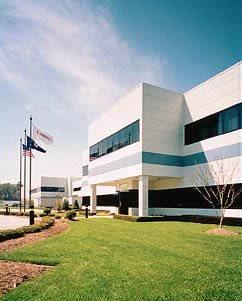 We actually saw only a tiny part of the overall Canon Virginia operation, namely that dealing with camera, camcorder, and lens repair, which occupies just a portion of one building. Other activities of Canon Virginia, Inc. include repairing and refurbishing printers and other products, a workforce development center, and massive facilities for recycling and manufacturing toner cartridges. In all, 2,000 employees work in 1.7 million square feet of facilities, spread across 165 acres of land.
We actually saw only a tiny part of the overall Canon Virginia operation, namely that dealing with camera, camcorder, and lens repair, which occupies just a portion of one building. Other activities of Canon Virginia, Inc. include repairing and refurbishing printers and other products, a workforce development center, and massive facilities for recycling and manufacturing toner cartridges. In all, 2,000 employees work in 1.7 million square feet of facilities, spread across 165 acres of land.
For reasons of corporate security and keeping proprietary information proprietary, we unfortunately weren't allowed to take any of our own photos inside the facility - So we just have the few photos on this page to share with you, provided by Canon.
Incoming!
Our group's tour ended at the shipping/receiving warehouse, although that's actually where the whole process begins.
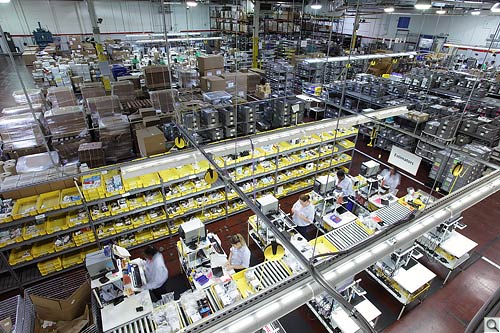
The photo above shows a portion of the warehouse area, see from an elevated catwalk that extends along two walls of the room. The near foreground is where customer cameras and lenses arrive for repair. As each product arrives, a manila tag carrying a unique barcode is attached to it. As each camera or lens progresses through the repair process, its barcode is scanned or "shot" every time it moves. (The motto is "if it moves, shoot (scan) it.") This provides real-time tracking of every piece of repair work in the facility, allowing each customer's product to be tracked to the specific bin or repair bench it's sitting on at any moment.
Other areas in mid-frame and background are where returned products from retailers arrive for refurbishment and CPS (Canon Professional Services) products arrive and leave. The arrangement here is an interesting example of Kaizen or "continuous improvement." The Canon facility has one main street number as its address, but incoming shipments for CPS, repair, and refurbishment are each sent to slightly different addresses that correspond to one of three shipping bay doors on the building. In this way, products destined for the three different departments arrive pre-sorted, saving time inside the facility.
Lens Testing
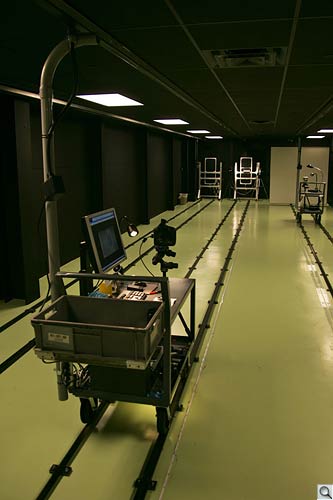 The first area we saw on our tour was the lens testing room, one view of which is shown below. Three sets of tracks on the floor support rolling optical benches, on which lenses being tested are mounted. It's a long room, fully 112 feet overall, with a total of six target/optical bench setups in it. (Each track supports two optical benches, facing test targets at opposite ends of the room.) While we imagine a number of tests can be done in this room, we were only shown the process for checking and adjusting autofocus accuracy. (Canon was extremely circumspect with almost all details of their test processes, considering them highly proprietary.) The shot immediately below shows the arrangement of tracks and targets, while the second image following shows three technicians testing lenses at one end of the room.
The first area we saw on our tour was the lens testing room, one view of which is shown below. Three sets of tracks on the floor support rolling optical benches, on which lenses being tested are mounted. It's a long room, fully 112 feet overall, with a total of six target/optical bench setups in it. (Each track supports two optical benches, facing test targets at opposite ends of the room.) While we imagine a number of tests can be done in this room, we were only shown the process for checking and adjusting autofocus accuracy. (Canon was extremely circumspect with almost all details of their test processes, considering them highly proprietary.) The shot immediately below shows the arrangement of tracks and targets, while the second image following shows three technicians testing lenses at one end of the room.
Lenses under test are attached to "reference bodies;" camera bodies with precisely-adjusted autofocus systems. In a process reminiscent of our use of the LensAlign test device in our own lab, the camera/lens is first autofocused on a target with a bold black/white focusing target. It's then switched to manual focus (so the focus point won't change), and the target holder is flipped over to display an angled target with fine detail to help determine exactly where the point of focus lies. The reference body is tethered to a laptop computer running software that analyzes the resulting image to produce a precise readout of focus accuracy. Based on that information, the technician can update the EPROM-based focus calibration table in the lens' processor. Repeating the process either confirms that focus accuracy is now up to spec, or that further tweaking is required.
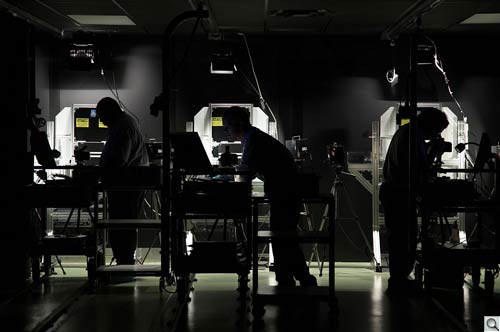
We were curious about how the repeatability of AF in the reference bodies affects adjustment of lenses under test, but that unfortunately fell within an area that Canon considered proprietary. Testing lenses on multiple bodies from a variety of manufacturers, we've often seen situations where a lens might work fine on one body but not on another, while other lenses would work focus on both. We suspect this is because focus accuracy is specified to be within a given range for both the bodies and lenses, and if a lens and body happen to be at opposite ends of their acceptable ranges, the result can be overall accuracy that's out of tolerance. While the Canon staff didn't directly comment on this analysis, they did note that they from time to time will take a customer's entire photographic kit (all bodies and lenses) in together, to insure that all the components play well with each other.
Service tipPerhaps the most useful piece of information we gleaned during our visit was the value of sending unretouched images showing the problem you're seeing along with a lens or body sent in for repair. The service manager we talked with said that this is by far the most useful communication they can receive from the customer to help them diagnose lens problems. Canon tells us that they can accept a CD, SD card, or CF card with unedited images that are in RAW/JPEG format (we assume that means RAW+JPEG for each image). They're also working on implementing an External File Upload process that will let customers upload their images electronically, via FTP, if they didn't send images with the product itself. Requests for this can be fielded by the Contact Center at CITS (Canon Information Technology Services).
Camera Repair
We're hoping to receive some better images showing lenses and cameras under repair, but we were amazed by how nonchalantly (albeit carefully) Canon's skilled technicians could strip down a camera. As another editor commented "It kind of gives you a new appreciation for the phrase 'no user-servicable parts inside.'" The density and complexity of the assemblies were mind-numbing to our unschooled eyes, but the techs were quite matter of fact in how they stripped them down. We imagine it would take quite a while to reach that level of comfort, and the service manager conducting our tour confirmed that technicians do move through a process of increasing proficiency, fully mastering one body at a time before stepping up to the next.
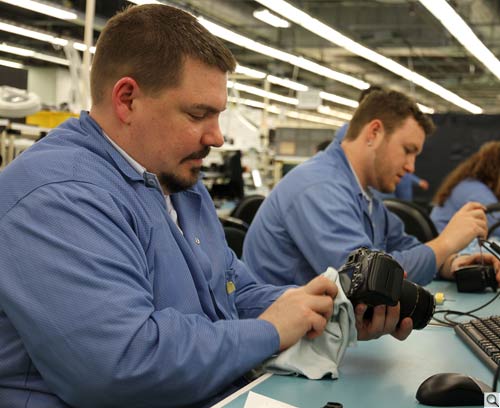
We don't have photos showing them, but the camera-test bays are rather different from the lens testing area. For one, they are much more compact, since they don't have to accommodate such a wide range of focal lengths: A single, medium focal length "reference lens" is used to calibrate the cameras' AF systems, so the test target can be much closer to the camera. There's also more equipment in the camera test bay, including a precision light source for calibrating exposure systems and a backlit color target for evaluating color accuracy.
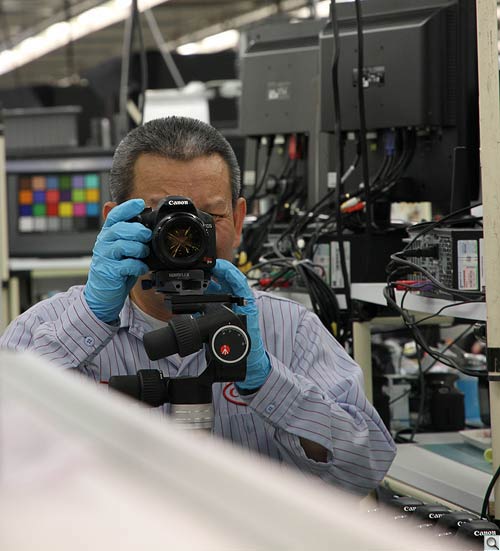
One thing we found surprising was the relatively small number of technicians doing the repair work: Particularly given the volume of incoming work we saw flowing through the shipping/receiving warehouse (presumably representing at least 20-25% of the repair volume for the entire US), there seemed to be remarkably few people doing the actual repair work. It was hard to get a exact count, but there seemed to be fewer than 20 people in the PowerShot repair area. These small numbers seem all the more remarkable when you consider the hundreds of thousands (millions?) of cameras Canon sells in the US every year.
Call Center
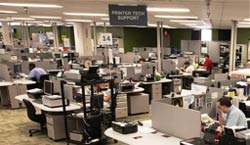 Being located some distance away, Canon's call center wasn't part of our tour, but it demonstrates another aspect of Canon's commitment to good customer experiences: At a time when many companies have moved their tech support overseas, Canon's customer support center in Chesapeake, VA holds 525 US employees in a 65,000 square foot facility, to handle all Canon's US tech support calls. All told, the 95% of these employees who are directly "customer facing" are projected to handle over 3 million customer contacts this year.
Being located some distance away, Canon's call center wasn't part of our tour, but it demonstrates another aspect of Canon's commitment to good customer experiences: At a time when many companies have moved their tech support overseas, Canon's customer support center in Chesapeake, VA holds 525 US employees in a 65,000 square foot facility, to handle all Canon's US tech support calls. All told, the 95% of these employees who are directly "customer facing" are projected to handle over 3 million customer contacts this year.
Conclusion
Facilities tours always aim to present the company involved in the best possible light, so you have to bring along your own shaker full of salt for seasoning. That said, Canon's customer support and service operations in Virginia are impressive in their own light; no corporate spin needed. (How often do you hear an American voice on the other end of a tech support call these days?)